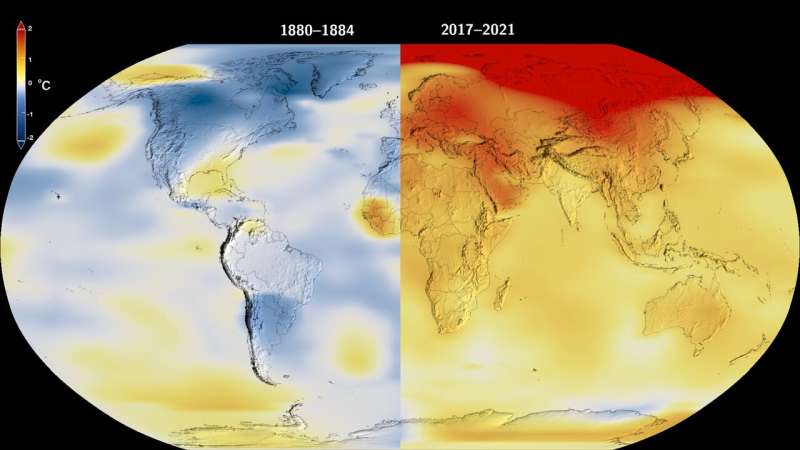Astrophysics student discovers link between global warming and locally unstable weather

Climate change gives rise to more unstable weather, local droughts and extreme temperature records, but a coherent theory relating local and global climate is still under active development. Now a Danish astrophysics student at the Niels Bohr Institute used a mathematical approach to unveil how global temperature increase engenders locally unstable weather on Earth.
With over 99 percent agreement among climate scientists, it is now clear that Earth is warming globally and that this warming is predominantly human-made.
Temperature increases faster than ever before, and Earth is probably at its warmest for over 100,000 years. Since the beginning of the Industrial Revolution about 250 years ago, the world has become 1.1 °C warmer.
Global and local warming
Climate change in recent years has given us extreme heat records, such as last year, when Canadians measured their highest temperature at almost 50 °C; five degrees warmer than the previous record!
But the problem is not limited to heat records: Cold waves, droughts, storms and precipitation also reaches new heights.
How global warming gives rise to local weather extremes is an active, though not yet fully understood, field of research. But with a new mathematical approach, master student Albert Sneppen just came one step closer to the connection between global temperature rise and the instability of local weather.

Inspiration from early Universe
Albert Sneppen spends his time studying astrophysics at the Cosmic Dawn Center, a basic research center under the Niels Bohr Institute and DTU Space in Copenhagen, and is used to pondering on black holes and exploding stars. One day he got the idea that a method normally used to analyze the distribution of light on the night sky could also be used to study the distribution of temperature fluctuations on the Earth’s surface.
The method is used in particular to interpret the so-called cosmic microwave background radiation, also known as the “Big Bang afterglow.” Suddenly Albert Sneppen saw a kind of “aesthetic coincidence” between heat distribution on the universal scale and the Earth scale.
“For decades, the heat radiation of the early Universe has been studied in the night sky. Researchers use the so-called ‘angular power spectrum’ which tells you how much all parts of the night sky—both locally and globally—are connected. And that is exactly what you want in climate research; a method of examining all scales of climate change at the same time,” Sneppen explains.
The structure of climate
The new mathematical perspective supports hitherto unknown structures in the climate.
In addition to reproducing Earth’s temperatures and confirming the observed climate trends on the largest scales, it shows how local weather fluctuations are created, i.e. on small scales. It turns out that fluctuations and differences on large scales are followed by fluctuations and differences on small scales.
“When we humans perturb Earth’s temperature on the largest scales, it causes larger temperature differences on all scales from regions of about 2,000 km, and all the way down to 50 km,” Sneppen explains.
In other words, climate change makes the differences in temperature grow locally—and with large temperature differences come even more extreme weather patterns.
“The instability and volatility of the weather has generally grown since the industrial revolution, but has especially gained momentum over the last 40 years,” says Sneppen. “Together with several other theoretical and observational studies, this model indicates that the weather will become even more unstable in the coming decades.”
Sneppen’s article has just been published in The European Physical Journal Plus.
New discovery about distant galaxies: Stars are heavier than we thought
Albert Sneppen, The power spectrum of climate change, The European Physical Journal Plus (2022). DOI: 10.1140/epjp/s13360-022-02773-w
Citation:
Astrophysics student discovers link between global warming and locally unstable weather (2022, May 25)
retrieved 25 May 2022
from https://phys.org/news/2022-05-astrophysics-student-link-global-locally.html
This document is subject to copyright. Apart from any fair dealing for the purpose of private study or research, no
part may be reproduced without the written permission. The content is provided for information purposes only.
For all the latest Science News Click Here
For the latest news and updates, follow us on Google News.

